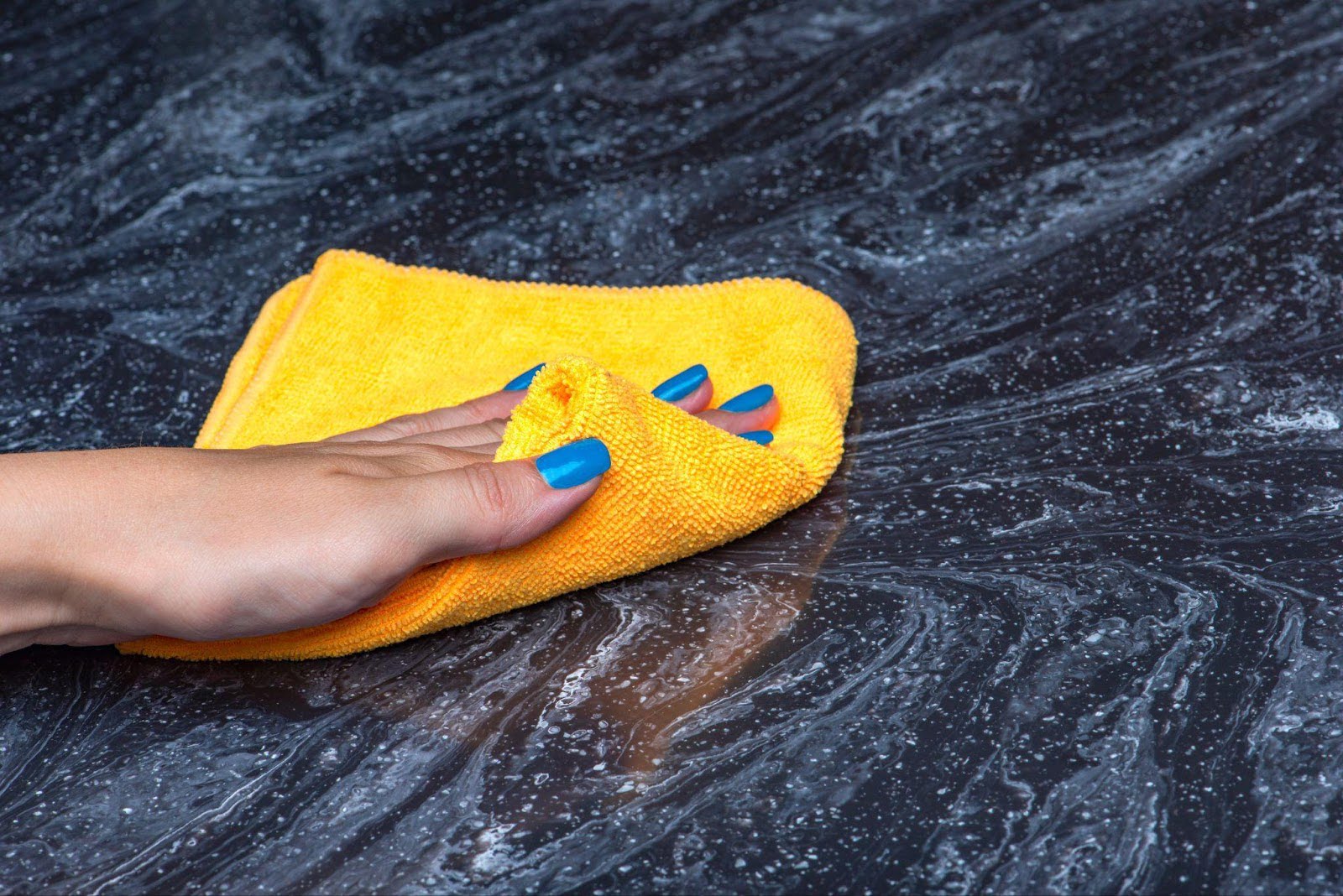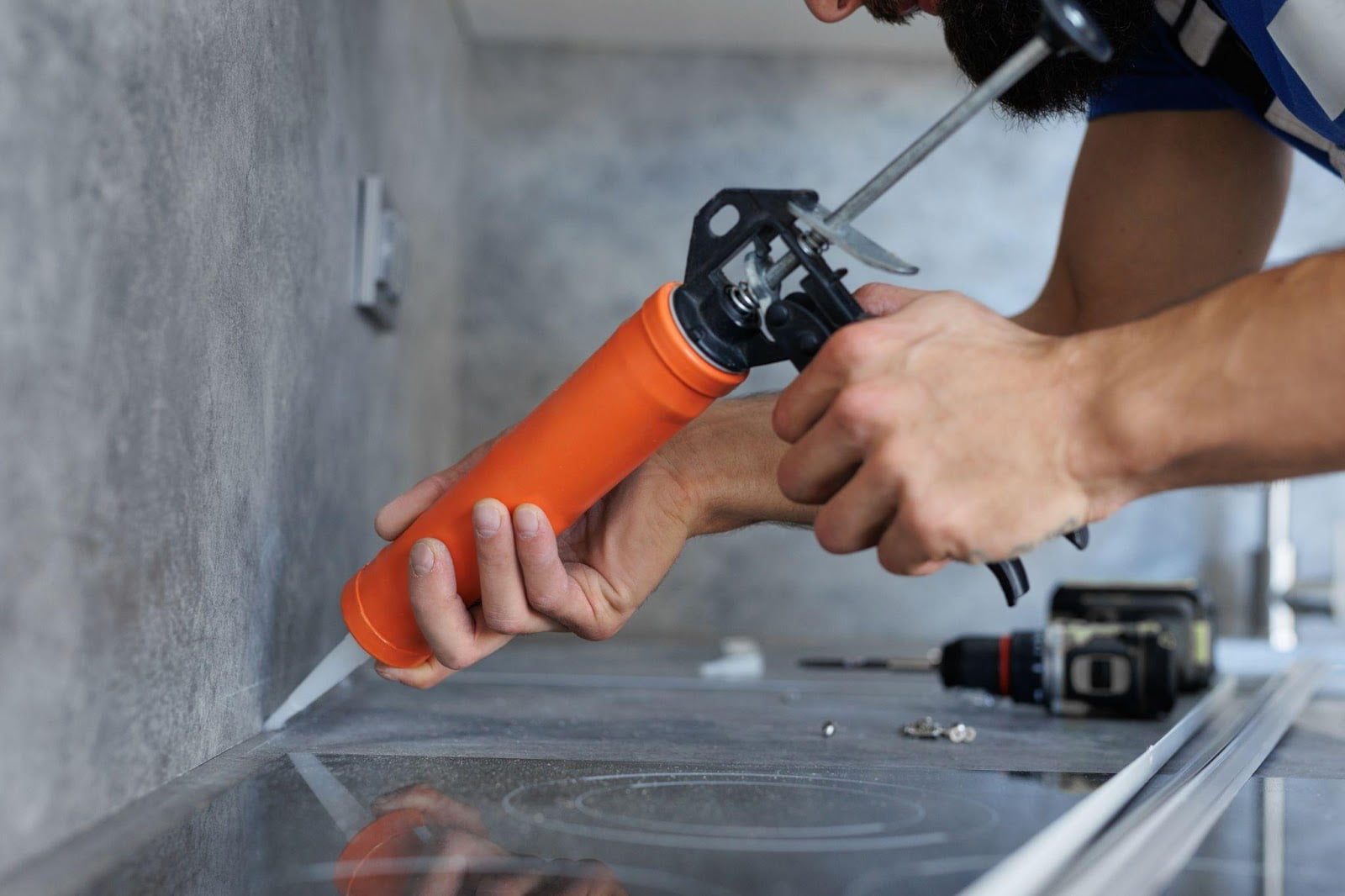The Ultimate Guide to Cleaning and Maintaining Stone Countertops

Welcome to your ultimate guide to cleaning and maintaining stone countertops. Whether your countertops are made of classic marble, rugged granite, sleek quartz, or another type of stone, it’s important to know how to maintain them properly.
This guide provides comprehensive advice on daily cleaning routines, deep cleaning strategies, the necessity of sealing, and methods for addressing scratches and chips.
By mastering these maintenance techniques, you’ll ensure that your stone countertops remain a dazzling feature of your home’s décor for many years to come. Let’s learn more.
About stone countertops
Stone countertops are premium surfaces used primarily in kitchens and bathrooms. They are crafted from natural stone slabs or engineered stone materials and are highly valued for their durability, natural beauty, and unique patterns.
Common types of stone include granite, marble, quartz (an engineered stone made from natural quartz and resin), and soapstone. Each offers distinctive colors and veining that contribute to its aesthetic appeal.
The type of stone you use significantly affects the countertop’s resistance to heat, stains, and scratches. Natural stone countertops, such as marble and granite, require periodic sealing to maintain their resilience and luster. In contrast, engineered stone, like quartz, is prized for its low maintenance needs and consistent finish.
Stone countertops enhance a space’s visual appeal and add to its functionality and resale value, making them a popular choice for home improvement and new construction projects.
Daily maintenance tips
Stone countertops are a beautiful, luxurious addition to any kitchen or bathroom. To keep their natural luster, you’ll need to properly clean and maintain them.
By following a simple daily cleaning routine, you can keep your stone countertops looking as good as new for years to come. Here are some easy daily maintenance tips to help you keep your stone countertops in pristine condition.
Wipe up spills immediately
Accidents happen, and spills are inevitable in a busy household. Wipe up any spills on your stone countertops immediately. Stone is porous and quickly absorbs liquids, leading to stains or damage. Use a soft cloth or paper towel to blot the spill, avoiding any rubbing or spreading. This will help prevent any permanent marks on your beautiful stone surface.
Use a gentle cleaner
When cleaning your stone countertops daily, it is important to use a gentle cleaner specifically formulated for stone surfaces. Avoid harsh chemicals, abrasive cleaners, or acidic solutions, as they can damage your stone and dull its shine.
Instead, opt for pH-neutral and non-abrasive cleaners that are safe for stone countertops. Dilute the cleaner with water according to the manufacturer’s instructions, and wipe the surface gently with a soft cloth or sponge.
Avoid using harsh scrub brushes or scouring pads

Never use abrasive scrub brushes, scouring pads, or steel wool on your stone countertops. These abrasive materials might scratch the surface and mar its natural beauty.
Use a soft cloth or non-abrasive sponge for daily cleaning. If you encounter any stubborn stains, apply a gentle cleaner directly to the stain and let it sit for a few minutes before wiping it away with a soft cloth or sponge.
Protect your countertops from heat
Although stone is a durable material, it can be vulnerable to sudden changes in temperature. Hot pots or dishes can cause thermal shock and potentially damage your stone countertops. Thermal shock occurs when a material rapidly changes temperature, causing stress that leads to cracks or breaks.
To prevent this, always use heat-resistant trivets or coasters when placing hot items on your stone surface. This will help maintain the stone’s integrity and protect it from heat-related issues.
Dry the surface thoroughly
After cleaning your stone countertops dry the surface thoroughly. Leaving any moisture on the stone promotes the growth of mold or mildew, which is difficult to remove.
Use a soft cloth or paper towel to dry the entire surface, paying particular attention to any areas where water may accumulate, such as around the sink or faucet. This will help prevent any potential damage and ensure the longevity of your stone countertops.
Deep cleaning and stain removal
Deep cleaning your stone countertop is essential to remove any built-up dirt, grime, and bacteria. To begin this process, remove any loose debris or crumbs from the surface using a soft-bristle brush or a damp cloth. This will minimize the possibility of scratching your countertop during the cleaning process.
Next, create a gentle cleaning solution by combining warm water and mild dish soap. Dip a soft cloth or sponge into the cleaning solution, wring out the excess water, and gently wipe the countertop in a circular motion. Ensure that you cover the entire surface, including edges and corners.
Stubborn stains
You may need to use specialized stone cleaners for stubborn stains or deeper cleaning. These cleaners are specifically formulated to remove tough stains without harming the stone’s surface.
Apply the stone cleaner according to the manufacturer’s instructions and use a soft cloth or sponge to work the cleaner into the stain or problem area. Avoid excessive force or scrubbing vigorously, as this might damage the stone. After treating the stains, rinse the countertop thoroughly with clean water to remove any residue from the cleaning products.
Grease or oil stains
You may sometimes encounter grease or oil stains on your stone countertop. These stains can be trickier to remove, but we’ve got you covered. Begin by blotting the stain immediately with a paper towel or a clean cloth to absorb as much oil as possible. Avoid wiping the stain, as this can spread it further.
Next, sprinkle a generous amount of baking soda on the stain and let it sit for 15-20 minutes. Baking soda acts as an absorbent and helps draw out the oil from the stone.
After the recommended time has passed, gently scrub the stain with a soft cloth or sponge, using a circular motion. Rinse the countertop with warm water and repeat the process if necessary. If the stain persists, you may need to consult a professional for further assistance.
To maintain the shine and smoothness of your stone countertop, it is imperative to dry the surface thoroughly after cleaning. Excess moisture can lead to water spots or streaks, diminishing the beauty of your countertops. Use a soft cloth or a microfiber towel to dry the entire surface gently. Pay attention to the edges and corners, as water accumulates in these areas.

Sealing stone countertops
Before diving into the sealing process, it is crucial to determine whether your countertops need sealing. Different types of stones have varying levels of porosity.
Granite, marble, and limestone are typically more porous, while quartzite and soapstone are less so. Porous stones require more frequent sealing, while non-porous stones might not need sealing at all.
An easy way to test the need for sealing is to sprinkle a few drops of water on the countertop’s surface. If the water quickly absorbs into the stone and causes dark spots, it is time to seal your countertops.
Gather the necessary supplies
To begin the sealing process, gather all the supplies you will need. First, you will need a quality stone sealer, which you can purchase from your local home improvement store. Choosing a sealer specifically formulated for your type of stone countertop is important.
Gather some clean, lint-free cloths, a soft-bristled brush, mild dish soap, and warm water. Having all the supplies ready will make the process quick and efficient.
Clean the countertops thoroughly
Before applying the sealer, it is crucial to clean the countertops thoroughly. Start by mixing a small amount of mild dish soap with warm water in a bucket or sink. Dip a clean cloth into the soapy water and gently wipe the countertop surface. Pay attention to any visible dirt, grease, or stains.
For stubborn stains, use a soft-bristled brush in a circular motion. Once the countertops are clean, rinse the cloth or brush in clean water and wipe the surface to remove any soap residue. Allow the countertops to air dry completely before proceeding to the next step.
Apply the stone sealer
Now that the countertops are clean and dry, it is time to apply the stone sealer. Shake the sealer bottle well before opening it. Pour a small amount of sealer onto a clean cloth and apply it evenly to the countertop surface.
Work in small sections to ensure thorough coverage. Allow the sealer to sit on the stone surface for the recommended time indicated on the product label. This usually ranges from 5 to 15 minutes, depending on the sealer used. During this time, avoid touching or using the countertops.
Wipe off excess sealer
After the required time has elapsed, use a clean cloth to wipe off any excess sealer that remains on the countertops. Make sure to remove all visible residue to prevent any residue buildup. Pay extra attention to the edges and corners of the countertops. Leaving excess sealer on the stone surface may produce a hazy appearance once dried.
Allow the countertops to dry completely, usually for at least 24 hours, before using them again.
So, there you have it.
Now you know how to clean and maintain your stone countertops.
Elevate your home with Rock Tops Surfaces
Ready to elevate your home with stunning stone countertops that combine beauty with resilience? Look no further than Rock Tops Surfaces, where we offer a wide selection of top-quality stone options tailored to meet your design and durability needs.
Our expert team is also on hand to provide guidance on the best care practices, ensuring your countertops remain as pristine as the day they were installed. Request a quote today and discover the perfect stone countertops to transform your space!

